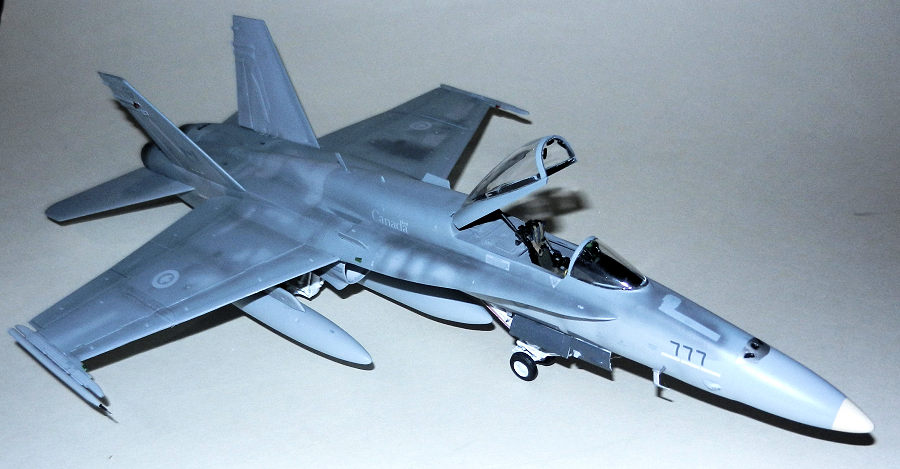
Revell-Monogram 1/48 CF-188A Hornet
| KIT #: | 6658 |
| PRICE: | CAD$90.00 (includes two kits) |
| DECALS: | One option per kit |
| REVIEWER: | Pablo Calcaterra |
| NOTES: | Leading Edge Decals 48.87 |

| HISTORY |
William Tell competition is conducted during even numbered years and involves aerial combat teams from the United States Air Force, based both in the U.S. and abroad, United States Air National Guard and the Canadian Air Force. The competition pits pilots, ground crew and weapons control teams against each other in a series of challenging air defense scenarios.
Beginning in 1996, Teams that attended the William Tell Weapons Meet were to be assembled differently than had been in the past. In previous Meets teams competed as units (Squadrons or Wings) but in 1996 each major Command, the Air Force Reserve, the Air National Guard, and a combined Canadian team would compete against each other for the right to be known as the best in the Air.
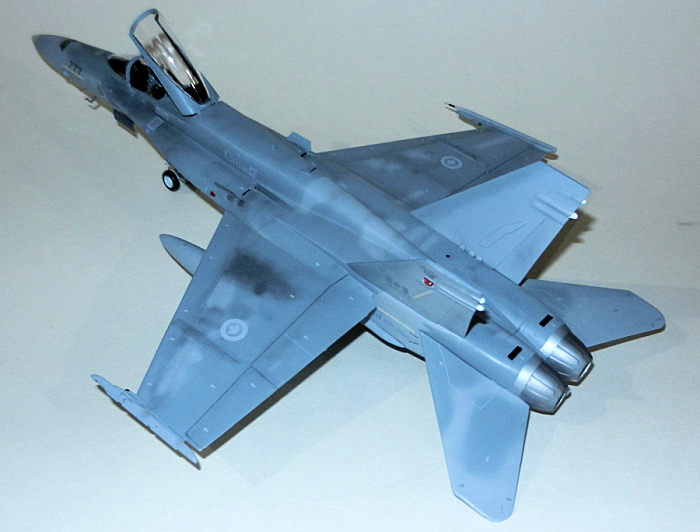 The
Air Combat Command included two F-16 Fighting Falcon pilots from Hill's 388th
Fighter Wing and two F-15C pilots from the 33rd Fighter Wing at Florida's Eglin
Air Force Base. The Pacific Air Forces were represented by F-15Cs from the 18th
Fighter Wing at Kadena, Japan, and F-16s from the 35th Fighter Wing at Misawa,
Japan. The Air Education & Training Command made its first William Tell
appearance with F-15Cs from Tyndall's 325th Fighter Wing and F-16s from the
173rd Fighter Wing at Kingsley Field in Portland, Ore.
The
Air Combat Command included two F-16 Fighting Falcon pilots from Hill's 388th
Fighter Wing and two F-15C pilots from the 33rd Fighter Wing at Florida's Eglin
Air Force Base. The Pacific Air Forces were represented by F-15Cs from the 18th
Fighter Wing at Kadena, Japan, and F-16s from the 35th Fighter Wing at Misawa,
Japan. The Air Education & Training Command made its first William Tell
appearance with F-15Cs from Tyndall's 325th Fighter Wing and F-16s from the
173rd Fighter Wing at Kingsley Field in Portland, Ore.
In 1996 Team Canada was made up of personnel and aircraft from 4 Wing Cold Lake and one person from 22 Wing North Bay, Ontario. The team consisted of six pilots, two air weapons controllers, thirty-nine aircraft technicians and ten support personnel. They operated and supported six McDonnell Douglas CF-18 Hornets for the two-day competition (October 23/25)
In short, while the Canadians were the only team flying the F-18 Hornet (CF-188) the U.S. teams flew F-15C Eagles, F-15E Strike Eagles and F-16 Fighting Falcons.
One month of intense workups took place prior to deployment to the competition on 19 October. Personnel prepared for the events which included live firing of air-to-air missiles, the countering of mass raids of simulated aggressors and air-to-air combat on an electronically scored range.
The pilots were scored on how they employed their aircraft and weapons systems. The Air Weapons Controllers were evaluated on how well the intercepts were executed. Technicians and weapons load personnel were rated on how quickly and efficiently aircraft were readied for missions. The lone Canadian team from 4 Wing in Cold Lake Alberta defeated six U.S. Air Force contingents
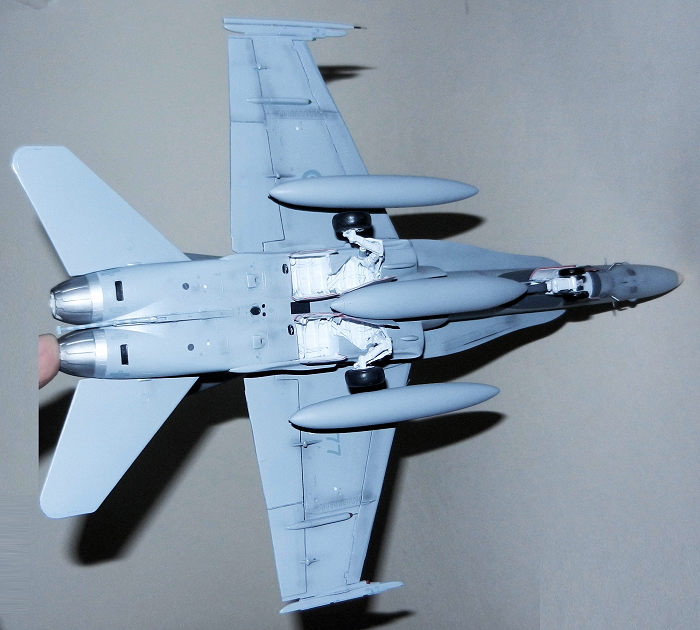 Team
Canada came first in six of eleven events, which helped it take top honours in
the competition. Team Canada finished first in the standings for Operations
Team, Profile 1, Aircrew Element, and Weapons Director Team. Staff Sgt Jeff
Craver, on exchange with the Canadian Forces from the United States Air Force
took Top Scope in the Weapons Director competition. The Canadians took home the
Gen. Daniel "Chappie" James Jr. Fighter Interceptor Team Award, named for the
Pensacola native who became the first black officer to achieve the rank of
four-star general in the U.S. military.
Team
Canada came first in six of eleven events, which helped it take top honours in
the competition. Team Canada finished first in the standings for Operations
Team, Profile 1, Aircrew Element, and Weapons Director Team. Staff Sgt Jeff
Craver, on exchange with the Canadian Forces from the United States Air Force
took Top Scope in the Weapons Director competition. The Canadians took home the
Gen. Daniel "Chappie" James Jr. Fighter Interceptor Team Award, named for the
Pensacola native who became the first black officer to achieve the rank of
four-star general in the U.S. military.
Capt. Steve Nierlich of Toronto and brother of a friend of mine, won the Top Gun award for the best individual score in aerial combat competition that included firing live missiles (for the first time in the competition) at unmanned drones and aerial duels against piloted drones that were scored electronically. I understand that Steve’s held at the time the record number of kills in such a short period of time (4 kills in 5 minutes) It was the first time a Canadian team has won the William Tell Air-to-air Weapons Meet since the event named for the legendary Swiss archer began in 1954.
In regards to 188777 this airframe was delivered on Jan 20 1987 and was stationed in CFB Cold Labe, aB and CFB Baden (Germany in the late 80s and early 90s. Transferred to 441 Sqn RCAF (Cold Lake) around 1995. After receiving an ECP avionics upgrade it was moved to 409 (TF) Sqn at the same base in May 2007. In May 2009 in was transferred to 425 Sqn at Bagotville. Continuing with the (crazy?) rotation it was seen with 409 Sqn markings in 2010. By 2016 it was back in CFB Cold Lake.
| THE KIT |
Using dark blue plastic for the Blue Angels this Revell Monogram kit has been around for many years. It builds into a very nice F-18. The only criticism I have is the lack of wing drop tanks. There are ejection marks in several parts that need to be sanded or filled with putty. Decals are very simple and mostly printed in yellow…for the Blue Angels! Instructions are good.
| CONSTRUCTION |
It is very straightforward. I painted all interior with dark grey and the instrument panel and ejection seat in black. Wheel bays were sprayed in white along with the assembled landing gear legs.
There are some issues that require the use of putty (chaff dispensers, top and bottom halves around nose and back of fuselage, underfilled top wings among others). Nothing serious but a bit time consuming and requiring attention.
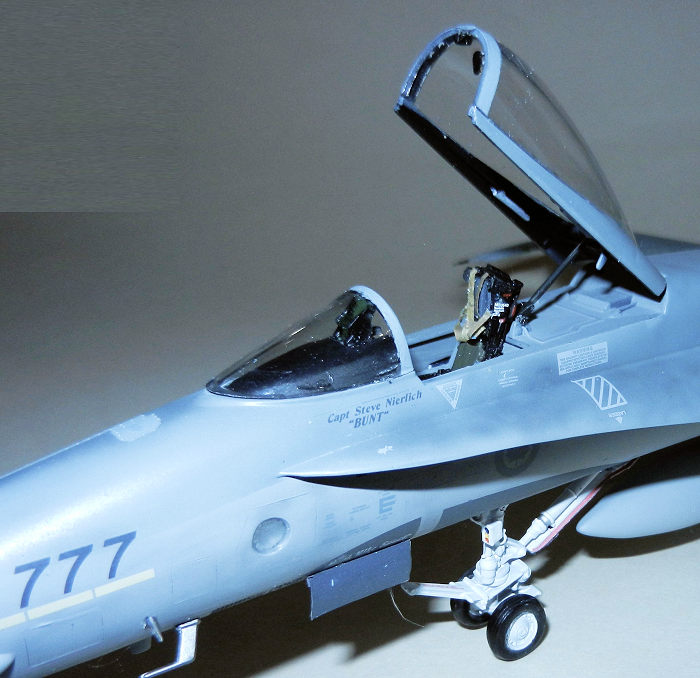 The
large spotlight located on the left side of the nose was recreated by drilling a
hole and putting a piece of plastic inside the nose. It was then painted in
silver and eventually (at one of the later stages) covered with a couple of
thick applications of Kristal Klear.
The
large spotlight located on the left side of the nose was recreated by drilling a
hole and putting a piece of plastic inside the nose. It was then painted in
silver and eventually (at one of the later stages) covered with a couple of
thick applications of Kristal Klear.
An extra set of sensors on the top of the tail needs to be sanded off. I also scratchbuilt the reinforcements located on the inside of the vertical surfaces. These were attached and kept symmetric using a template I crated and tape holding the top of the vertical surfaces in place in a way that they touched the template. The L braces at the fuselage/tails union was were scratchbuilt.
Drop tanks were from the kit (1 ventral) and the 2 under the wings came from the Esci F-18 (should I say F-17??) kit, with several parts added and the nose and tail thinned out to match the profile of the Revell tank. With all those modifications the kit is ready to be painted after covering the cockpit and wheel bays with wet tissue paper.
| COLORS & MARKINGS |
After a coat with light grey Vallejo Primer the entire plane was painted with ModelMaster FS 36375. Using the McDonald’s Douglas image that I have framed at home and that celebrates Steve’s accomplishment at William Tell (the 6 CF-18s in flight led by Steve) I sprayed the top of the plane following a blotchy pattern in FS 35237 very diluted and with 20 psi in my airbrush. First time I have used this technique (thanks Anthony and Fabian!) and it has worked marvelously.
Exhausts were painted in silver with some drops of black. Nose tip was painted with Model Master Radome Tan. With very diluted dark grey paint (around 90:10 water:paint) and high pressure the stains and dirt were added again following the image of the Steve’s plane in flight. The landing gear legs were attached to get the kit ready for the sticky coats of Future.
After several thin coats of Future I applied the Leading Edge decals. The set has enough decals for 2 planes and covers all the different fonts for letters and numbers used by the 18s thru the years. It includes the decals with Steve’s name and his ground crew Chief.
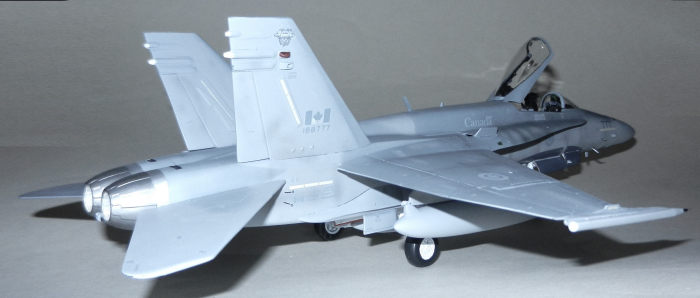 They worked
great and they are excellent. Note that in the image of the plane in flight it
is clear to see that instead of having “777” on the top of the right wing there
is another RCAF roundel. A coat of Model Master Acryl semi gloss covered and
protected the decals.
They worked
great and they are excellent. Note that in the image of the plane in flight it
is clear to see that instead of having “777” on the top of the right wing there
is another RCAF roundel. A coat of Model Master Acryl semi gloss covered and
protected the decals.
From this moment on everything went fine and fast: starting with the undersides and from the center moving outwards I glued the ventral tank, wheels and doors, wing tanks and wingtip missile launchers. The antennas and sensors under the nose were added at this point. Main landing gear light was attached to the nose leg and the 3 small lights on the box attached to the same part were painted blue, yellow and red.
Moving to the top the gunsight and windshield were glued. Decals for the seat came from Leading Edge. The two red navigation lights were glued to the top of the tails. Then all navigation lights (wingtips, undersides, those close to the LEX fences) were all painted first with silver (as a base) and then clear red and green.
Three photoetched rear mirrors painted black (front) and silver (back) were attached to the canopy. The internal side of the exhausts were painted in a creamy colour. The tip of the tail sensors were painted in white. The target designator on the rightside wingtip came from the Revell Monogram F-16 kit.
With the canopy attached in the open position the CF-188 was finished.
| CONCLUSIONS |
A very straightforward it if were not for the need to use putty in several places and the changes required to make a Canadian plane. Decals are highly commended.
Dedicated to Steve and the 1996 team!
Thanks to:
Leanne Nierlich
Anthony Goodman (IMPS London, ON)
Fabian Vera
| REFERENCES |
https://www.combatsim.com/printer.php?action=review&id=83&page=1
https://www.mcchordairmuseum.org/REV%20B%20OUR%20HISTORY%20UNITS%20MISC.%20%20WT%201990's.htm
https://www.f-106deltadart.com/williamtell.htm
Pablo
Calcaterra 19 July
2024 Copyright ModelingMadness.com. All rights reserved. No
reproduction in part or in whole without express permission. If you would like your product reviewed fairly and fairly quickly, please
contact the editor or see other details in the
Note to
Contributors.